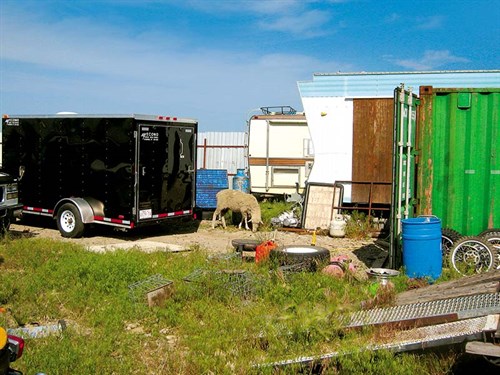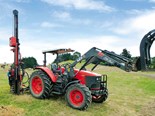Farm safety tips: how to keep safe on the farm
When it comes to farm safety, first impressions do count. Warren Mills is managing director of CR Management Systems in Australia and writes that safety can depend on the good attitude you have towards yourself, and that safe practice routines can protect you and those around you.

First impressions, as we know, last longest. And while we also know you can't tell a book from its cover, there are certain clues we always get from what we see on the surface of things.
If a WorkSafe officer was visiting as a follow up to a workplace accident, which they are most likely to do, then the impressions your property and machinery makes on them will be very important.
If on one hand, they see disorder: junk, rubbish, broken-down machinery, fences, sheds etc, then this is what they will be looking for in their investigations. They will think: "Whose fault was this?" suspecting if there was an injury, it was probably a result of negligence traceable back to you.
If on the other hand, they see your property is well-maintained with grass cut, fences and gates in good order, buildings painted and looking cared for, they will start thinking: "What went wrong?"
Of course, you are always entitled to a proper investigation, but how this commences and is conducted will be very much determined by how things look on the surface. I am suggesting this unconscious attitude is reasonable as it is based upon experience and the reasonable proposition that if a workplace is well controlled, then accidents are less likely, where the converse proposition is equally true – if a workplace is chaotic and poorly managed, accidents are more likely.
Usually, the sort of workplaces that engage a consultant like me are of the first type. This makes my job easy, because I am preaching to the converted, usually about the finer points of the systematic safety doctrine, rather than trying to convince the employer of the wisdom of safety.
Occasionally however, I have been asked to consult to workplaces of the second type usually because they are in terminal decline and are looking for the silver bullet, or they have been given a provisional improvement notice with which they must comply.
My purpose in making this statement as my introduction to safe workshop practice on farms, is to say if you are serious about safety, it will be obvious in how your place looks to the well-trained eye. If you want to be taken seriously by your employees or authorities, clean up. Put the junk in one orderly location, fix the fences and gates, cut the grass, fix the spouting and paint the house. Is this just window dressing or the beginning of a systematic approach to safety? You be the judge.
Workshop safety
If you agree with me on just cleaning the place up and making it orderly, then there are plenty more things you should do, which I will cover in subsequent articles, particularly in the maintenance, use and storage of machinery, but here are some for starters.
There should be a designated place to work on machinery that has the following features:
Hard floor
Your workshop should have a hard floor that is safe to jack up heavy vehicles without the jack or a safety-stand subsiding.
Good lighting
The area must also be well lit, either naturally or by good artificial lights.
Well maintained. No farm workshop is ever going to be completely tidy and dust-free, and most will not have doors, but I am talking about being free from old accumulations of dirt, hay, grass, waste oil and assorted junk from when Grandpa pulled down the Blue Fordson Major to fix her up and didn't get around to finishing the job.
Waste storage
All workshops have waste storage, some more than others. I am not talking about how you dispose of waste oil, batteries, tyres, filters etc, although I will discuss these in later articles. I am talking about wastes being properly stored. Oil and solvents should be in 205-litre drums, batteries should be stored off the ground and not broken and leaking acid. Tyres should not be collecting water that breeds mosquitoes.
The junk yard. Similarly, all workshops have an area to store junk: old machines, assorted steel, vehicles, empty containers and tyres. At least, this should be orderly and free from fire risks and extreme sharp edges.
Machinery storage
Not all machines are going to have a cosy shed for their off season, but at least those items that are going to be called into service again should have the basics attended to, such as keeping the weather out of the cabin and the tyres kept inflated. For safety and security, the keys should be removed and the hydraulics lowered, so if the kids happen to play in a machine, the chances of them seriously injuring themselves are reduced.
Remove batteries
If you were to do all of the foregoing, I would say well done. If you were to remove and properly store batteries, I would say excellent, particularly, if you were to keep them on a trickle charge to keep them fully charged rather than discharged or dead flat.
Keep service records
Some OH&S legislation requires owners "pass on machinery service records" somewhat optimistically, as if there would be a detailed written summary of service and repairs carried out similar to what might be expected of an aircraft. While I have seen such records created by local government, workshops and mining companies, the best record most farms have would be the date written on an oil filter, when it was changed at the beginning of the last season, whether it needed it or not.
While service supplier invoices would be kept for particular services, most farm servicing is not recorded. I would strongly recommend you at least make diary notes referencing the schedule in the operators handbook or workshop manual.
For the latest farm machinery reviews, subscribe to Farm Trader magazine here.
Keep up to date in the industry by signing up to Farm Trader's free newsletter or liking us on Facebook













